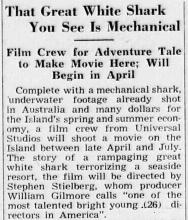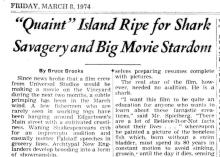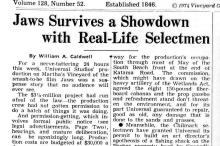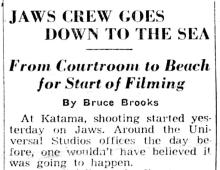For a nerve-tattering 24 hours this week, Universal Studios’ production on Martha’s Vineyard of the smash-to-be film Jaws was a suspense story that no audience will ever see.
The $3 1/2-million project had run afoul of the law — the production crew had not gotten permission to do a batch of things it was doing.
And permission-getting, which involves formal public notice (see legal advertisements, Page Two), hearings, and mature deliberation, can be agonizingly long. Production costs are budgeted at $30,000 a day.
By 9 o’clock Tuesday night Louis James Fargo, Universal’s urbane, bearded production manager, was deeply impressed enough by the trouble Jaws was in to tell the Edgartown board of selectmen:
“If I have to wait three weeks, I might as well just pack up and go home.”
But by nightfall Wednesday the legal underbrush had been hacked away. The show would go on, under these terms:
•Universal would apply, and duly did, for permission to continue building stage-set cabanas and a gazebo and indeed a false-front hot dog stand on the grounds of the Norton & Easterbrooks boatyard on Fuller street. Inside, work would go forward gussying up the fishing boat on which half the action of the film will take place — and on fabricating the mechanical 24-foot stand-in for the shark that is to Peter Benchley’s novel as Moby Dick is to Melville’s.
•Rather than seek in Superior Court an injunction to stop preparations for shooting on location, which is scheduled to start next week, the selectmen can choose to proceed in district court against a zoning code violation. If they choose to go that route, the prosecution could ask that the owner be fined $50 for each day of nonconforming use. It would be the first fine so levied for a zoning infraction.
•Yesterday morning Mr. Fargo exchanged with the town conservation commission letters clearing the way for the production’s occupation through most of May of the South Beach front at the end of Katama Road. The commission agreed the eight 150-pound cabanas and the prop gazebo and refreshment stand don’t threaten the environment, and for its part Universal guaranteed to repair, good as old, any damage that is done to the sands and grasses.
•Meanwhile, the Chilmark selectmen have granted Universal its permit to build an art director’s apotheosis of a fishing shack on the Packer property hard by Seward’s Seagoing Grocery on the Menemsha waterfront.
The conservation commission’s resolution of its fraction of the problem was a little melodramatic.
At Tuesday night’s meeting of the selectmen — we’ll get to that in a moment — the commissioners had asked Jim Fargo to meet them at the opening to the Katama beach at 4:30 p.m. next day. With him when he arrived in a chauffeur-driven station wagon was Joe Alves, the art director, carrying two big sketches in color of the setting as it will look. These he laid on the hood of a car, hissing and flapping in a wild north wind, and the commissioners crowded around and asked questions, slowly turning blue.
In response Mr. Fargo and Mr. Alves led them out onto the beach, along which the sand was streaming in the wind and biggish waves were thundering, and, in turn to the tops of the two steep dunes that flank the entrance from road to beach. Alongside walked Michael Wild of the Conservation Society staff, presenting to the Universal people copies of the society’s Wetlands Guide and How to Build and Save Beaches and Dunes, by John A. Jagschitz (University of Rhode Island Press).
Answers:
1. Starting Monday, the cabanas and the two bigger props will be settled on the flat sands between the two dunes. On the primary dune to the north a lifeguard’s perch will be set. Most of the shooting — with a 35-mm. Panaflex camera, hand-held or on tripods but no scaffolding ever — will be done from the south dune. If lights are needed, a mobile generator will be hauled up, as in National Guard encampments on the beach in years past, and if the shooting is done by sunlight the light will be controlled by reflection from so-called shiny boards.
2. Shooting is scheduled to start May 2. That will involve the passage of the novel in which the police discover what’s left of the shark’s first helping of people.
3. The properties will remain on the beach under 24-hour security guard until May 28, if all goes according to timetable, but during much of that time the shooting will have gone to sea — off the beach at the bend in the road between Edgartown and Oak Bluffs — for the shark-hunting sequences leading up to the catastrophe.
4. During the week closest to Memorial Day, when it is trusted the water will have warmed enough to let a couple of hundred extras (most of them Vineyarders) appear to be enjoying themselves in the surf, the last beach scenes will be shot, to be edited into their chronological place in the film.
The Shifting Scene
By 5 o’clock the commissioners — even such veteran outdoorsmen as chairman Edwin G. Tyra and Alfred Doyle — had had it. Standing on a dune, Mr. Fargo noticed that the configuration of the beach had changed since last time he looked — a new point of sand had made out here, burying the old war-rehearsal bunker, and a series of little cliffs had been sawed at the foot of the dunes, and, concerned about the credibility of the film if the location differs from sequence to sequence, he asked where he might get some sand to bring to South Beach. The commissioners went back to the road and clambered into Richard I. Colter’s green Jeep station wagon and had their meeting. There and in a later conference at Universal’s quarters in the Christine Pease house on North Summer street the agreements were worked out.
Mr. Fargo had dropped in on the selectmen’s meeting Tuesday to acknowledge that the sign identifying Universal’s diggings in the old Pease house was in violation of the zoning for that residential block and to say he’d apply for a variance to permit it. While he had the floor he thought the selectmen should know he’d be asking for permission in the middle of May to decorate the town as for Fourth of July; there’d be some filming in the harbor east of the Norton & Esterbrooks wharves during the next fortnight; some traffic control — not enough to hamper business — would be needed during the action with maybe 100 extras on Main street about May 14 or 15.
The roof began falling in, slowly.
Fred B. Morgan Jr., chairman of the board, asked whether the use of a boat storage shed for the construction of sets and a boat constituted a change of use that could be authorized only by the zoning board of appeals after due application for a special permit.
Mr. Fargo said whatever Universal had done was done in good faith, and Mr. Morgan said the selectmen were sorry this hadn’t been discussed earlier.
“We’ll have to get a legal opinion,” said William C. Parks, one of the selectmen. “The owner is aware of the zoning laws. I think there was an obligation on him to bring the situation to your attention and to ours.”
“We’ll have to conform with the zoning by-law,” Mr. Morgan said.
“The only way I can put it,” said Mr. Fargo, “is that we have done a number of locations throughout the country, and city governments have taken us on our performance record. We keep our word. This is entertainment. We are not in the business of oil or real estate. What we are selling is an illusion. Municipal councils have always held it is not a business.”
It was pretty glum, but next morning carpenters were back in the boathouse yard hammering cabanas together, and by yesterday the only question left unsettled was how a nonconforming use like that could have gone so long unexamined.
Robert J. Carroll, head of the ownership of Norton & Easterbrooks, said no violation of the zoning pattern was involved, and added:
“I went the whole route early; I touched all the bases, with town counsel, with my own attorney, and frankly I am at a loss to understand why obstacles would be raised now. This is a chance for everybody to make money.”
Richard J. NcCarron, town counsel, said he had referred Mr. Carroll to his own attorney.
Universal Studios personnel said the boathouse carpentry has been going on in plain view of police, selectmen, and town officials. “There’s no way to build a cabana surreptitiously,” said one.
One star role has been cast, Mr. Fargo said: Roy Scheider as the chief of police.











Comments